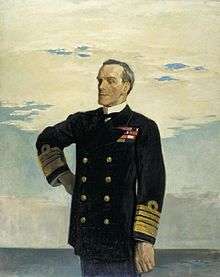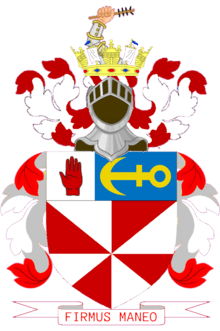Doveton Sturdee
Admiral of the Fleet Sir Frederick Charles Doveton Sturdee, 1st Baronet GCB, KCMG, CVO (9 June 1859 – 7 May 1925)[1] was a Royal Navy officer. After training as a torpedo officer, he commanded two different cruisers and then three different battleships before becoming commander of the 1st Battle Squadron of the Home Fleet. He went on to command the 3rd Cruiser Squadron and then the 2nd Cruiser Squadron.
Sir Doveton Sturdee, Bt | |
|---|---|
 Sketch of Sturdee for Naval Officers of World War I | |
| Born | 9 June 1859 Charlton, London |
| Died | 7 May 1925 (aged 65) Camberley, Surrey |
| Buried | St Peter's Church, Frimley |
| Allegiance | United Kingdom |
| Service/ | Royal Navy |
| Years of service | 1871–1921 |
| Rank | Admiral of the Fleet |
| Commands held | Nore Command 4th Battle Squadron 2nd Cruiser Squadron 3rd Cruiser Squadron 1st Battle Squadron HMS New Zealand HMS King Edward VII HMS Bulwark HMS Bedford HMS Porpoise |
| Battles/wars | Anglo-Egyptian War First World War |
| Awards | Knight Grand Cross of the Order of the Bath Knight Commander of the Order of St Michael and St George Commander of the Royal Victorian Order |
Just before the start of the First World War Sturdee became Chief of War Staff at the Admiralty. In November 1914 the Royal Navy suffered a serious defeat at the Battle of Coronel. In response Sturdee was sent to the South Atlantic to seek out the German squadron, commanded by Graf Maximilian von Spee, which had caused the damage at Coronel. On 8 December 1914, while coaling at Stanley, Sturdee encountered von Spee and the subsequent action became known as the Battle of the Falkland Islands. Von Spee, finding that he was engaged with a superior force, was forced to flee. In the course of the pursuit Sturdee's forces sank almost the entire German squadron. Only one light cruiser escaped but she was hunted down in March 1915.
In the closing years of the war Sturdee served as commander of the 4th Battle Squadron in the Grand Fleet and then as Commander-in-Chief, The Nore.
Naval career
Early career
Born the son of Captain Frederick Sturdee RN and Anna Frances Sturdee (née Hodson) in Charlton, Kent,[2] Sturdee was educated at the Royal Naval School at New Cross and then joined the Royal Navy as a cadet in the training ship HMS Britannia on 15 July 1871.[1] Promoted to midshipman on 19 July 1873, he was appointed to the frigate HMS Undaunted, flagship of the China Station in 1876.[3] Promoted to sub-lieutenant on 9 June 1878 and to lieutenant on 7 February 1880,[4] he joined the brig HMS Martin at Portsmouth in May 1880 and then transferred to the torpedo depot ship HMS Hecla in the Mediterranean Fleet in February 1881.[3] He took part in the bombardment of Alexandria in July 1882 during the Anglo-Egyptian War.[3]
After completing a course on torpedoes at HMS Vernon Sturdee became a torpedo officer on HMS Bellerophon, flagship of the North America and West Indies Station, in 1886 before returning to HMS Vernon as an instructor in 1889.[3] Promoted to commander on 30 June 1893,[5] he transferred to the Admiralty as a torpedo specialist in the Directorate of Naval Ordnance.[3] He became commanding officer of the cruiser HMS Porpoise on the Australian Station in November 1897 and became involved in managing the tensions with Germany and the United States over the Samoan Islands in 1899.[3] His handling of this situation, which involved a tense stand-off with the German representatives, earned him his promotion to captain on 30 June 1899,[6] and his appointment as a Companion of the Order of St Michael and St George in the 1900 New Year Honours list on 1 January 1900[7][8] (he was invested in person by Queen Victoria at Windsor Castle on 1 March 1900[9]).
Sturdee returned to the Admiralty as assistant director of naval intelligence (foreign division) from 1 January 1900, serving as such until 16 October 1902, when he was appointed in command of the protected cruiser HMS Minerva.[10] Appointed a member, 4th class, of the Royal Victorian Order (MVO) on 21 April 1903 during King Edward's visit to Malta,[11] he became commanding officer of the armoured cruiser HMS Bedford in the Home Fleet in November 1903.[3] He went on to be commanding officer of the battleship HMS Bulwark and Chief of Staff to the Commander-in-Chief of the Mediterranean Fleet in May 1905.[12] Advanced to Commander of the Royal Victorian Order on 16 April 1906,[13] he became commanding officer of the battleship HMS King Edward VII and then of the battleship HMS New Zealand in a new role as Chief of Staff of the Channel Fleet in 1907.[12] He was appointed an aide-de-camp to the King on 26 October 1907.[14] Promoted to rear-admiral on 12 September 1908,[15] he became Rear Admiral commanding the 1st Battle Squadron of the Home Fleet, with his flag in the battleship HMS St. Vincent, in 1910.[12] He became President of the Submarine Committee of the Admiralty in early 1911 and then became commander of the 3rd Cruiser Squadron of the Home Fleet, with his flag in the cruiser HMS Shannon, in December 1911.[12] He went on to become commander of the 2nd Cruiser Squadron of the Home Fleet, with his flag in Shannon again, in 1913.[12] He was appointed a Knight Commander of the Order of the Bath on 3 June 1913.[16] Promoted to vice-admiral on 13 December 1913,[17] he became Chief of War Staff at the Admiralty in July 1914.[12]
First World War
.jpg)
In November 1914 the Royal Navy suffered a moral defeat when it lost two armoured cruisers at the Battle of Coronel. After Winston Churchill insisted that Sturdee should not be made a scapegoat for the events at Coronel, Admiral Lord Fisher sent a squadron commanded by Sturdee, with his flag in the battlecruiser HMS Invincible, to the South Atlantic to seek out the German squadron, commanded by Graf Maximilian von Spee, which had caused the damage at Coronel.[18] This decision was compounded by the fact that Fisher "detested" Sturdee and wanted to remove him from the Admiralty.[19] On 8 December 1914, while coaling at Stanley, Sturdee encountered von Spee and the subsequent action became known as the Battle of the Falkland Islands. Von Spee, finding that he was engaged with a superior force, was forced to flee. In the course of the pursuit Sturdee's forces sank almost the entire German squadron, including the armoured cruisers, SMS Scharnhorst and SMS Gneisenau. Only the light cruiser SMS Dresden escaped but she was hunted down in March 1915.[20] For his part in this important naval action Sturdee was created a baronet on 15 March 1916[21] with the title "of the Falkland Is."[2]

Sturdee became commander of the 4th Battle Squadron in the Grand Fleet, with his flag in the battleship HMS Benbow, in January 1915 and directed his squadron at the Battle of Jutland in May 1916.[20] He was advanced to Knight Commander of the Order of St Michael and St George on 31 May 1916[22] and awarded the Cross of Commander of the French Legion of Honour on 15 September 1916.[23]

Promoted to full admiral on 17 May 1917,[24] Sturdee was appointed Grand Officer of the Italian Order of Saints Maurice and Lazarus on 11 August 1917,[25] and became Commander-in-Chief, The Nore in March 1918.[20] He was promoted to Admiral of the Fleet on his retirement on 5 July 1921[26] and advanced to Knight Grand Cross of the Order of the Bath on 1 January 1921.[27] He was President of the Society for Nautical Research (1922–1925).[28]
Personal life

In 1882 Sturdee married Marion Andrews (died 1940): they had a son and a daughter.[3]
Sturdee retired to Camberley, in Surrey, and died there on 7 May 1925. He was buried in the churchyard of St Peter's Church in nearby Frimley. His gravestone incorporates a cross made from the timbers of Nelson's ship, HMS Victory. His grandson William Staveley[29] and grandson-in-law Edward Ashmore were also Admirals of the Fleet.[30]
Arms
 |
|
See also
- Lieutenant General Sir Vernon Sturdee, his nephew
References
- "Doveton Sturdee". Oxford Dictionary of National Biography. Retrieved 7 December 2014.
-

- Heathcote, p. 238
- "No. 24810". The London Gazette. 10 February 1880. p. 622.
- "No. 26422". The London Gazette. 14 July 1893. p. 3981.
- "No. 27099". The London Gazette. 14 July 1899. p. 4345.
- "New Year Honours". The Times (36027). London. 1 January 1900. p. 9.
- "No. 27154". The London Gazette. 16 January 1900. p. 286.
- "Court Circular". The Times (36079). London. 2 March 1900. p. 6.
- "Naval & Military intelligence". The Times (36904). London. 21 October 1902. p. 5.
- "No. 27560". The London Gazette. 2 June 1903. p. 3525.
- Heathcote, p. 239
- "No. 27908". The London Gazette. 27 April 1906. p. 2875.
- "No. 28079". The London Gazette. 12 November 1907. p. 7581.
- "No. 28178". The London Gazette. 18 September 1908. p. 6760.
- "No. 28724". The London Gazette (Supplement). 30 May 1913. p. 3903.
- "No. 28783". The London Gazette. 19 December 1913. p. 9338.
- Massie, p. 248
- Halpern, p. 247
- Heathcote, p. 240
- "No. 29512". The London Gazette. 17 March 1916. p. 2932.
- "No. 29751". The London Gazette (Supplement). 15 September 1916. p. 9071.
- "No. 29751". The London Gazette (Supplement). 15 September 1916. p. 9081.
- "No. 30084". The London Gazette. 22 May 1917. p. 4942.
- "No. 30227". The London Gazette (Supplement). 10 August 1917. p. 8208.
- "No. 32394". The London Gazette. 19 July 1921. p. 5733.
- "No. 32178". The London Gazette (Supplement). 1 January 1921. p. 4.
- Murphy & Oddy, p. 26.
- Heathcote, p. 235
- "No. 47160". The London Gazette (Supplement). 1 March 1977. p. 2825.
- Burke's Peerage, Baronetage & Knightage, 102nd edition. 1959.
Sources
- Halpern, Paul G. (1994). A Naval History of World War I. Annapolis, Maryland: Naval Institute Press. ISBN 1-55750-352-4.
- Heathcote, Tony (2002). The British Admirals of the Fleet 1734 – 1995. Pen & Sword. ISBN 0-85052-835-6.
- Massie, Robert K. (2004). Castles of Steel: Britain, Germany, and the Winning of the Great War at Sea. London: Jonathan Cape. ISBN 0-224-04092-8.
- Murphy, Hugh & Derek J. Oddy (2010), The Mirror of the Seas; A Centenary History of the Society for Nautical Research London, Society for Nautical Research. ISBN 978-0-902387-01-0
External links
| Wikimedia Commons has media related to Doveton Sturdee. |
- The Dreadnought Project: Doveton Sturdee
- Biographical information from the Churchill Centre, University of Cambridge.
| Military offices | ||
|---|---|---|
| Preceded by Sir George Callaghan |
Commander-in-Chief, The Nore 1918–1921 |
Succeeded by Sir Hugh Evan-Thomas |